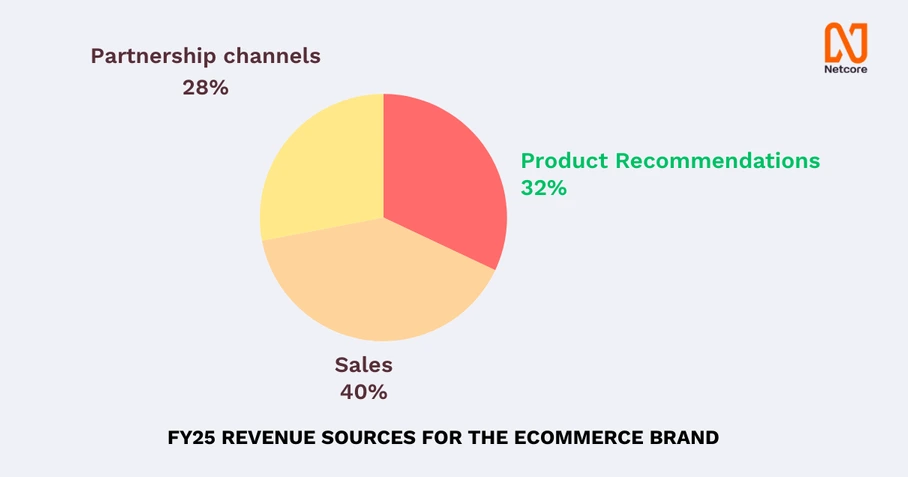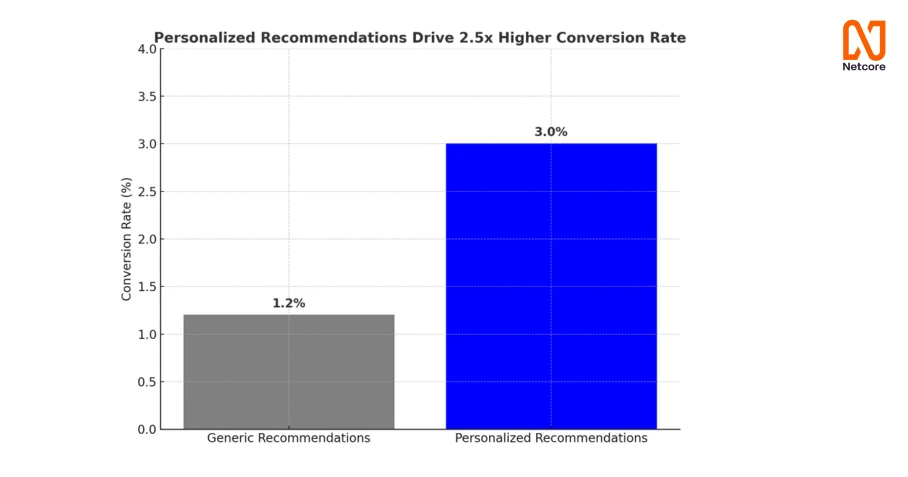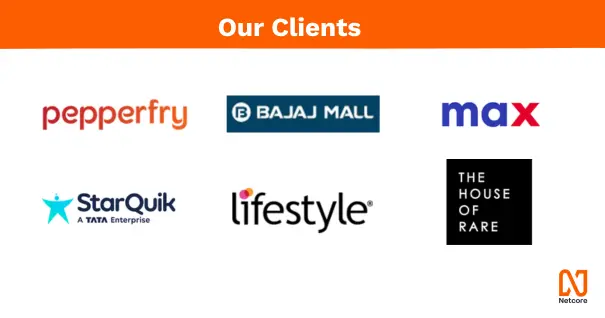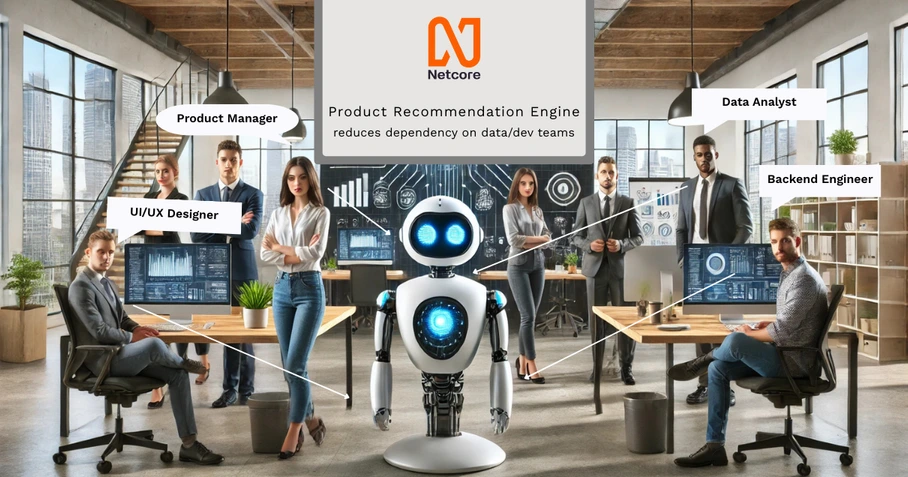This fast-growing ecommerce brand was struggling to convert newly registered users into paying customers. With a conversion rate stuck at just 5% and a bounce rate spiking to 78%, the brand was forced to rely heavily on paid marketing just to keep traffic and sales flowing. Despite efforts to manually design product recommendation sections for different customer segments, the approach couldn’t keep up with the rapid addition of SKUs and constantly shifting customer behavior.
As a result, users were often shown generic, one-size-fits-all suggestions that lacked relevance, leading to lower engagement, weak personalization, and missed sales opportunities.
To overcome these challenges, the brand implemented Netcore’s AI-powered product recommendation engine, introducing dynamic, user-level personalization across key touchpoints. The impact was immediate and measurable:
- 32% of total revenue was now driven by personalized product recommendations.

- The conversion rate for personalized recs was 2.5x higher than generic ones.

- And repeat purchase rates saw a significant 22% lift due to better-targeted, personalized, and real-time suggestions.

Leading brands across industries that trust Netcore
In this case study, we’ll explore the factors behind the brand’s low Registration-to-Purchase Rate and how AI-powered personalization helped turn the situation around.
Why Shoppers Aren’t Buying: A Conversion Rate Case Study for the Ecommerce Brand
Below are some challenges that the ecommerce brand faced without personalization on its ecommerce website:
1. Users See Irrelevant Products Right After Signing Up
Without personalization, every user visiting the ecommerce website comes across the same homepage or product feed, no matter their interest, intent, or behavior. It’s like walking into a store with random items on display.
Result: Users feel overwhelmed, unimpressed, or ignored, and leave the website before buying.
2. No Smart Navigation
With no smart product recommendations engine in place, the users were overwhelmed by options or didn’t know where to begin after signing up. This increases the friction in the buying journey, leading to a conversion rate as low as 5%.
Problem: Lack of intelligent navigation or “next best action” guidance.
3. No Re-Engagement After Registration
Without personalized push notifications or reminder emails, registered users simply drifted away. The ecommerce brand lacked a system for sending automated, behavior-based communications. Consequently, there were no relevant product suggestions or special offers to re-engage these users, leading to a rapid decline in engagement.
Result: Lost opportunities to convert highly interested users after they signed up.
4. Cold Start Experience
Lacking product history and any memory of user preferences, the experience offered only generic lists. This absence of personalization, failing to leverage past behavior insights, meant the initial user experience wasn’t great, leading to drop-offs just at the first stage of the user’s buying journey.
5. No Feedback Loops
Feedback loops are absolutely crucial for effective website personalization because they provide the intelligence needed to continuously improve and refine the personalized experiences delivered to users. Without them, personalization efforts become stagnant, inaccurate, and ultimately less impactful. And this was one of the major reasons why the ecommerce brand website faced high drop-offs.
6. Different Teams Working in Silos
Without user behavior feeding the ecommerce brand’s marketing engine, different teams working on separate categories ended up sending offers and emails to customers, where there was no nurture sequence or personalization. This resulted in Lower open rates, click-throughs, and ROI on their campaigns.
7. Limited User Segmentation & Targeting
Because the brand used manual segmentation based on simple demographics (like age and gender) instead of rich behavioral insights, website visitors felt a disconnect. They likely doubted whether the brand offered anything that truly aligned with their personal tastes and preferences, causing them to drop off. Here’s a scenario from the brand’s challenge before switching to Netcore.

Individual 1: Maya, 30 years old
- Actual Interests: Maya is a professional working in a corporate environment. She prefers classic, tailored clothing like blouses, pencil skirts, and blazers in neutral and muted tones. She values quality and timeless style. She recently browsed for “silk blouses for work.”
- Segmentation: Maya falls into the “Women (25-35)” segment.
- Homepage Experience: Upon landing on the “Style Haven” homepage, Maya sees:
- A large banner advertising trendy, bohemian-style dresses with floral prints.
- A section featuring “Popular Items for Young Women,” which includes casual graphic tees, distressed denim shorts, and brightly colored accessories.
- Recommendations for “weekend getaway” outfits with a relaxed and informal vibe.
- Maya’s Reaction: Maya finds the homepage completely misaligned with her professional wardrobe needs. The styles are too casual and trendy for her taste. She doesn’t see anything that resonates with her recent search for silk work blouses. She concludes that this site likely doesn’t cater to her professional style and leaves.

Individual 2: Chloe, 32 years old
- Actual Interests: Chloe is a stay-at-home parent who enjoys comfortable, casual clothing like leggings, tunics, and soft knitwear. She also likes vibrant colors and playful patterns. She recently browsed for “comfortable nursing tops.”
- Segmentation: Chloe also falls into the “Women (25-35)” segment.
- Homepage Experience: Chloe sees the exact same homepage as Maya:
- A large banner advertising trendy, bohemian-style dresses with floral prints.
- A section featuring “Popular Items for Young Women,” which includes casual graphic tees, distressed denim shorts, and brightly colored accessories.
- Recommendations for “weekend getaway” outfits with a relaxed and informal vibe.
- Chloe’s Reaction: While some of the items might be closer to Chloe’s casual style than Maya’s professional attire, the overall focus on trendy, going-out styles and the lack of specific recommendations for comfortable everyday wear or nursing-friendly options also leaves her feeling that the site isn’t quite right for her current needs. She might browse a little longer, but without seeing anything particularly relevant to her recent search or general preferences, she’s also likely to leave.
Due to the above challenges, the brand faced difficulty in optimizing the customer journey with no clear visibility into where and why users drop off. Hard to run an effective A/B test campaign based on behaviour patterns due to ever-changing customer preferences and new SKUs getting added every few days.
Evaluating the Impact of Using Product Recommendations
1. Increased Revenue & Sales
By using Netcore’s AI-powered carousels and web push notifications, the ecommerce brand surfaced highly relevant products when users were considering a purchase. This reduced decision fatigue and encouraged more users to convert after registration. As a result, the brand saw an increase in transaction volume, and the average registration-to-purchase rate rose to 28%. This improved RTPR signifies more conversions from existing traffic, ultimately requiring less paid customer acquisition per sale later in the customer journey.
2. Loyal Customer Base & Repeat Purchases Increased by 22%
As customers began their journey, smart product recommendations prompted initial purchases. Over time, personalization fostered trust and relevance, which the ecommerce brand used to deliver more personalized offers, leading to a significant increase in repeat purchases.
3. Better Targeting & Personalization
Before implementing Netcore’s product recommendation engine, the brand manually segmented users using cohorts based on insights entered into the system. This process was unsustainable for the marketing team due to significant friction between the product and marketing teams. There was a substantial time lag between requesting cohort analysis for recommendations and implementing the changes. During this delay, new SKUs were frequently added, and audience segmentation would often change based on trend analysis.
Essentially, Netcore’s product recommendations allowed the ecommerce brand’s marketing team to leverage real-time user behavior (browsing, searches, bookmarks) to power highly relevant carousels and web push notifications, leading to increased click-through and conversion rates.
4. Improved Cross-Sell by Leveraging Zero Result Search Queries
Netcore’s AI algorithm regularly analyzed user search logs to identify the most common zero-result queries. Instead of a generic “no results found” page, the brand used this information to offer alternative product recommendations that matched the initial search intent. For example, if a user searched for “red leather boots with a 3-inch heel” and the exact match wasn’t available, they recommended “Similar red leather boots.” This not only provided a positive customer experience but also helped leverage cross-selling opportunities to increase revenue.
5. Deeper Customer Understanding & Insights
Each interaction with a recommended product enriched the user profile, allowing the brand to build more accurate personas and improve future targeting. This also enabled the marketing team to develop more personalized offers and plan campaigns using intent-based, category interest, and price sensitivity segments. The brand could send fresh, relevant product recommendations to returning users each time, keeping the brand top-of-mind. The product recommendation engine continuously re-engaged users with content and products they genuinely cared about, fostering ongoing value perception.
6. Operational Efficiency & Scalability
The brand shifted from increasing ad spend to automatically re-engaging high-potential users through personalized touchpoints. This better Registration-to-Purchase Rate (RTPR) has brought stability to the ecommerce brand’s forecasting and inventory management. As a result, they are on a path to double their business.
Getting Started is Easier Than You Think
Netcore streamlines your product recommendation strategy by handling the technical heavy lifting. We manage integration and onboarding, connecting smoothly with platforms like Shopify and Magento. This eliminates the need for specialized staff such as data scientists, web developers, product managers, and UI/UX designers. Easily control and update recommendations through our user-friendly, ready-to-use platform, and leverage expert guidance from your dedicated Customer Success Manager for powerful remarketing campaigns.

Conclusion
That’s how Netcore’s AI-powered product recommendations helped a leading ecommerce brand transform its user journey—from registration to repeat purchase. By surfacing the right products at the right time and enabling real-time personalization across the funnel, the brand achieved:
- A 28% increase in Registration-to-Purchase Rate
- A 22% lift in repeat purchases
- Smarter targeting, reduced operational friction, and scalable revenue growth.
What started as a tactical solution evolved into a long-term growth engine, boosting not just sales but also marketing efficiency and customer loyalty.

Ready to See What Netcore Can Do for You?
If you’re looking to improve conversions, scale revenue, and drive stronger customer relationships, let’s talk. Even a brief consultation with our experts can uncover quick wins and long-term strategies tailored to your ecommerce business.
Book a guidance call with Netcore’s expert today and discover how AI-powered personalization can turn your website or app into a high-converting, retention-focused growth engine.
 Holiday Sales Are Won Now — Grab the 2025 Holiday Marketing Guide to Unlock More Revenue.
Holiday Sales Are Won Now — Grab the 2025 Holiday Marketing Guide to Unlock More Revenue. 









